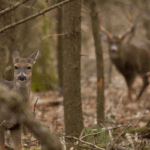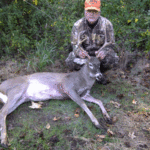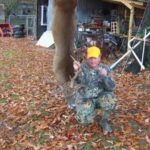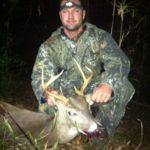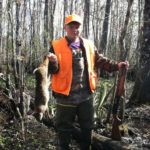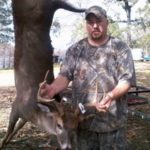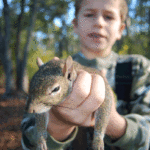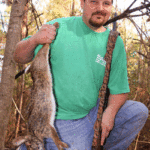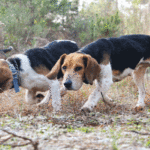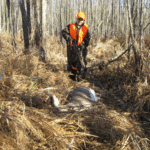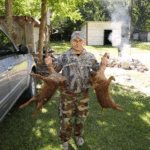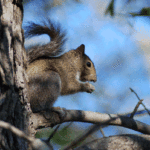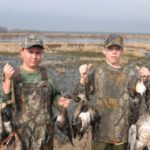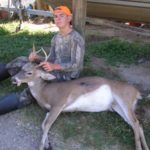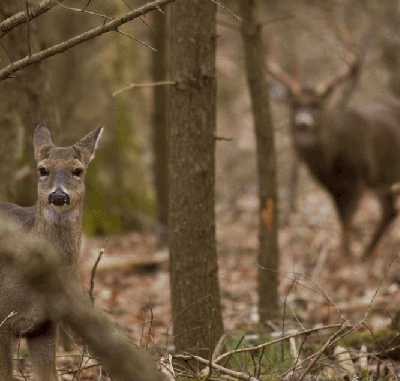
It’s time to start planning your hunting season, so here’s a look at what the wildlife management areas across the state have to offer.
Did you know when mast-producing trees are stressed, as they are in a drought, they produce a bumper crop of acorns?
Or that a wildlife management area in Louisiana is devoted exclusively to youth hunting and youth hunting education only?
Did you know one 19,000-plus-acre WMA is bordered by a 100,000-plus-acre national wildlife refuge, which combined gives deer hunters optimum opportunities to hunt and kill deer — some large animals, at that — on the vast public bottomland hardwood region?
Or that the table for the upcoming hunting season is set perhaps better than in many previous years based largely on the mast crop, that the overall health of wildlife in late summer is above average and that, yes, after one of the worst floods in history in that region, Sherburne WMA should shine as a hunting option in the Atchafalaya Basin?
Talk to eight dedicated biologist supervisors around the state long enough, and those and other nuggets of information come to light. Those state Department of Wildlife & Fisheries professionals and their staff manage nearly 1.5 million acres of public land for you to hunt, fish, boat, camp, hike, bird-watch and photograph nature in God’s country — the Sportsman’s Paradise.
“I like working on WMAs because we’re able to start projects and monitor them through time and measure the success,” Christian Winslow of Covington said, noting that isn’t always possible on private lands. “That’s one of the great things about managing WMAs.”
Winslow —whose responsibilities include Maurepas Swamp, Pearl River, Sandy Hollow and Tunica Hills WMAs — is the biologist supervisor in the Gulf Coast Coastal Plain, one of four major regions managed by the LDWF.
The others are North Mississippi Alluvial Valley, the South Mississippi Alluvial Valley and the Coastal & Nongame Resource Division.
Their WMAs, no matter how remote, are used frequently, and range from the land of towering oaks and piney woods to the cypress- and tupelo gum-lined swamps and marshes.
Valuable insight into how those environments and the wildlife they support are faring before the first shots of 2012-13 was provided by the regions’ respective biologist supervisors for this annual WMA hunting outlook in the Louisiana Sportsman.
Wendell Smith of Lake Charles, who oversees WMAs in the Gulf Coastal Plain, is one of the biologist supervisors who will tell you the mast crop is excellent on his areas going into the season. Some might find that hard to fathom considering the drought his region experienced the past few years.
“I thought we’d lose the mast crop completely last year and it did the opposite,” the 22-year LDWF veteran said the second week of July, noting a forester explained that bit of nature to him. “It’s a survival instinct for the trees. When trees are stressed, the instinct is to put out a lot of seeds or acorns, when an oak tree is stressed.”
Beech trees in his region produced more acorns than he’s seen in four years, and all the oak trees had more acorns, too, he said.
“We classify mast trees — zero, low, medium to high. The majority of our trees were medium to high,” Smith said. “On all of our WMAs, most of the surveys were real high. Squirrels (and other wildlife) had plenty to eat last year, so we should have a lot of them.”
One of the top squirrel-producing WMAs in his region, he said, is West Bay WMA. (See his report on page XX.)
Charles Booth of Farmerville looks forward to discussing WMA hunting prospects because it gives him a chance to talk about great youth-hunting projects like that on Floy McElroy WMA in Richland Parish, which was donated to the LDWF around 1990 by the late Floy W. McElroy with a personal request the 681-acre property be used for youth hunting and education.
“Due to its limited size and purpose, the property is restricted,” Booth said. “Currently, youth dove hunts, deer hunts and squirrel hunts are held. Dove hunts are held the second weekend of the first split.”
Those interested in the youth dove hunt can access the property of Louisiana Highway 137/U.S. 425 two miles north of Rayville.
Youth deer hunting is restricted to those youngsters selected as a result of a pre-application lottery, he said, noting four weekends are available for youth deer hunting and youths who apply can choose from one of those weekends listed on the lottery form.
Past youth deer hunts have been successful, Booth said. For example, in 2011-12, 53 youth hunting efforts were made over the four weekends hunts and 19 deer (11 of them bucks) were taken.
Many WMAs around the state afford the opportunity to kill trophy deer. A prime candidate each season is Big Lake WMA in the North Mississippi Alluvial Valley, which is supervised by Lowrey Moak.
Why Big Lake?
Moak said Boeuf WMA, Buckhorn WMA and Sicily Island Hills WMA have their share of big bucks.
“However, Big Lake WMA most likely offers the best chance at harvesting a big deer in this part of the eco-region. Big Lake WMA is a 19,000-plus acre management area consisting of a solid block of bottomland hardwood that shares its entire east boundary with the 100,000-plus acre Tensas National Wildlife Refuge. These two areas combined have all the essentials required to produce quality deer,” Moak explained.
The fact that Sherburne WMA in the nation’s last great overflow swamp is considered a top public area for hunting deer, rabbits and squirrels this season is a tribute to its resilience, according to Jonathan Bordelon of Marksville, North Mississippi Alluvial Valley biologist supervisor.
Sherburne experienced record flooding two springs ago but when the waters receded deer, squirrel and rabbit harvests were fair to good in 2011-12, Bordelon said.
Gulf Coastal Plain
When there’s talk among avid hunters about some of the best public places to hunt in the Gulf Coastal Plain region of Louisiana, much of it eventually centers around the perennial heavyweights like Fort Polk Wildlife Management Area, West Bay WMA, Jackson-Bienville WMA, Bodcau WMA, Pearl River WMA and Tunica Hills WMA.
You won’t get an argument from Wendell Smith of Lake Charles, Jeffery Johnson of Saline or Christian Winslow of Covington, the biologist supervisors who oversee wildlife and management practices on those and other WMAs that make up the GCP.
There’s a place, it seems, to satisfy every hunter’s desire, from bow hunting deer on Loggy Bayou WMA to scanning tree limbs for squirrels at West Bay WMA to going after rabbits with beagles on Maurepas Swamp WMA.
Those areas were among the leaders in reported harvests last season and should be again in 2012-13.
Johnson, the 35-year-old biologist supervisor and 10 1/2-year veteran with the LDWF who graduated with a bachelor’s degree in forestry with a concentration on wildlife management from Louisiana Tech University, is as excited about the upcoming season as anyone who shoulders a rifle, shotgun or bow.
But he also had some words of wisdom about big deer and hunting in general.
“I would like to remind all the hunters that everyone’s opinion is different as to what constitutes a big deer, quality buck, trophy buck or whatever you want to call it,” he said. “If you are out after a big buck then that is great, but at the same time, if you are out on a WMA to harvest a doe, that is great, also. We need all kinds of hunters to keep this sport going and to help manage our deer herds on the WMAs.
“So whatever your game of choice, method of choice or overall goals may be, when on a WMA let your primary goals be hunter safety and having fun. With the right attitude every outdoor and hunting experience can be a positive one.”
Speaking of positives, all three of the region’s biologist supervisors said habitat, mast and browse conditions on their respective areas were good to excellent going into August.
Western Region:
“Oh, it seems like it rains every day over here,” biologist supervisor Wendell Smith said the third week of July. “It’s been a wet summer. All this rain — it’s definitely beneficial. It’s going to look good going into August.
“Habitat conditions are excellent with the plenty of spring and early summer rainfall.”
The rain was a welcome sight after a mild winter, fairly wet spring and consistent summer rains in the region, said Smith, who has spent the last 12 of his 22 years with the LDWF as a biologist supervisor.
For sure, thousands of hunters probably will appreciate the wet stuff’s effects before the hunting season.
Thousands? Yes. WMAs in this region are popular, as the numbers from last year show.
They were led by Fort Polk WMA, which amassed 11,640 users (people scouting; squirrel, rabbit and deer hunters; sightseers; hikers; birders; etc.); following by Clear Creek WMA, 1,309; West Bay WMA, 10,368; Peason Ridge WMA, 3,446; and Sabine Island WMA, 2,619. Those numbers are from July 2011 to June 2012.
“There’s a lot of use on those areas,” Smith said.
Deer
Many of those WMA users last fall and winter targeted deer on the Gulf Coastal Plain. Top harvests from reports last season were Fort Polk WMA, which yielded 400 deer; Clear Creek WMA, which gave up 350 deer; West Bay WMA at 250; and Peason Ridge, which produced 200 deer.
Smith said the kill was about average.
“We were worried about them not responding as well to the drought as other years, but the numbers came in about the same as what we had before,” he said. “Animals, they’ll find a way to survive. I think this year will be about the same as last year.”
Smith said he and his staff manage deer based on the harvests each year; they look at the average kill numbers to determine the status of the deer herd.
“Say Clear Creek: as long as the kill is 350-400 deer, we know they’re all right,” Smith said. “We also check the weights; if the weights start getting lighter (based on the 10-year average), we know there’s something wrong.”
There’s nothing wrong with the deer herds on his WMAs. Smith noted there have been lots of deer fawn observed — many twins with their moms.
“It’s going to be a good year if we have some real cold weather. When it’s not cold, they don’t want to move,” Smith said. “I hope cold fronts come through early in the season so hunters can take advantage of the early rut we have down here.”
According to Smith, some of the biggest racks of the season could come off West Bay WMA, as they did last season.
That said, the top-producing WMA for consistent “big rack deer” is Peason Ridge WMA.
“However, all the WMAs in my district have the potential for producing fine bucks,” he said.
Squirrel
West Bay WMA also had the largest squirrel harvest in his region last season with 1,211 squirrels reported killed.
“We’ve always done well on squirrel hunting on West Bay WMA,” Smith said.
That the mast crop came through the drought period in excellent shape was a pleasant surprise to many. A forester, though, pointed out to Smith that in stressful times mast-producing trees put out more seeds or acorns in a survival instinct.
“All of our WMA mast surveys were real high,” he said. “Squirrels had plenty to eat last year, so we should have plenty of them.”
How has Sabine Island WMA fared squirrel hunting-wise since Hurricane Rita tore it up in 2005? Well, squirrel hunting success is improving with each passing year, as more and more people start using it, Smith said.
When all the trees were broken, twisted and crashed on the ground during the storm, hunter access became more than a challenge on what was for decades the flagship WMA for squirrel hunting in the South. Hunters would see or hear a squirrel but would have a hard time getting to it or, as the biologist supervisor said, “You’d run into a wall.”
Smith said Mother Nature has improved the situation, as the damaged trees are starting to rot away and the understory is opening up again.
“It’s starting to thin out a little bit,” he said. “God, they’ve got squirrels in there. It’s just hard to get to them.”
Rabbit
Most of the rabbits in this region this season may come from Clear Creek WMA and West Bay WMA.
That was the case last season when 75 rabbits were reported harvested from each of those WMAs.
“Everywhere we go we’re seeing lots of rabbits — more than we have in several years,” Smith said.
Noteworthy
Turkey hunters should be encouraged by the fact Smith and his staff have seen “lots of turkey poult” in their travels on the Gulf Coastal Plain WMAs.
Northern Region:
Weather conditions have been mostly favorable for wildlife deer, rabbits, squirrels and turkey going into the upcoming season, said Jeffery Johnson, biologist supervisor for the northern region of the Gulf Coastal Plain.
“Spring rains brought our area of the state out of the drought,” Johnson said July 22 from his Minden office. “Early summer was tough, though, with little rain and drought conditions were creeping back up on us. Significant rains have helped things out.
“I think with some rain off and on for the rest of the summer, everything will be in pretty good shape. We should have pretty good browse conditions and a pretty good mast crop. This will be good for wildlife, but may again make it tough on hunters to pinpoint the food sources that deer are using the most.”
A week later he remained confident of a good hunting season — even though rain was still needed.
Everything’s chugging along about the same,” Johnson said. “We’re starting to get a little dry again, but we’ll be all right.”
Gulf Coastal Plain WMAs in the northern region are known for their deer populations, both in terms of quality and quantity.
Jackson-Bienville WMA, Camp Beauregard WMA and Bodcau WMA had the most deer killed last season, Johnson said.
But there’s more to it than that.
“Most all of the WMAs in this part of the state are good producers for deer,” Johnson said. “Which one is best may depend on more how you like to hunt than the total number of deer harvested on the WMA.”
Of course, bowhunters kick things off.
“For bowhunters, farther north (on) Soda Lake, Loggy Bayou and Bayou Pierre WMAs are all good options,” Johnson explained. “Soda Lake and Bayou Pierre are bow-hunting-only, and Loggy Bayou is primarily bow hunting with limited gun seasons.”
Options are just as good moving south.
“Bowhunters farther south would stand a good shot on any of the WMAs in that area, but I would say their best bet would be on Alexander State Forest because the gun season is fairly short on this WMA and because much of the area is designated as archery hunting only,” he said.
The self-clearing deer harvest numbers from last season bear that out.
Alexander State Forest WMA led the way with 22 deer killed in 464 bowhunter efforts, while Loggy Bayou WMA followed with 20 deer killed in 743 bowhunter efforts.
Camp Beauregard WMA produced 16 deer in 648 bowhunter efforts, and Bayou Pierre WMA gave up 12 deer kill in 534 bowhunter efforts.
As a whole, Johnson said he was looking for some great hunting.
“I think the deer populations are in good shape,” he said. “We haven’t had that bad a summer so far. There are plenty of deer there. It’s just a matter what kind of weather we get.”
Deer
Reported deer harvest totals tell the tale for deer hunting success in the northern region of the Gulf Coastal Plain:
Jackson-Bienville WMA — 35
Camp Beauregard — 181
Bodcau WMA — 148
But good deer hunting on public lands in this part of the state doesn’t start and end with those three WMAs. As Johnson called the prospects geographically for bow hunting here, he outlined them for other all hunters.
“For gun hunters, farther north the top three would be Jackson-Bienville, Bodcau and Union,” he said. “Union and Bodcau open for modern firearms at the same time as Area 2 opens for modern firearms. Both have good deer herds.
“I would expect a little higher body weights at Bodcau, but Union throws some big ones every year, as well.”
And that third WMA is just plain hard to bet against.
“Jackson-Bienville makes the list because it has been a consistent producer for deer for years,” Johnson said. “The J-B opens a little later in November and runs through the month of December. It regularly produces good, quality deer.”
Which one to hunt just depends.
“So for those three, I’d say hunt them depending on the timing and when you can hunt,” Johnson said. “Bodcau and J-B both have some fairly liberal either-sex hunting, so it is easy to get some days in on either of them.
“Union also has a fairly liberal season for its size, and provides a lot of opportunity.”
Then Johnson turned his attention to the lower part of the region.
“Farther south, I would suggest Camp Beauregard, Sabine or Alexander State Forest,” he said. “Due to the sizes and/or uses of these WMAs, the either-sex gun seasons on these WMAs are more concise, but they are all three still good producers for deer during the gun hunts.
“I’d suggest hunters just check the hunting regulations for the dates on these WMAs, and then choose which is most convenient for them.”
Of course, many deer hunters dream of looking down the barrel at barrel-chested bucks with oversized racks on them. Johnson tried to point them in the right direction.
“For gun hunters to the south, I would suggest the same two areas as for the archery hunters, although Sabine is also capable of producing some pretty decent bucks also,” he said. “Farther north, I would suggest hunters focus on Bodcau, Union and Jackson-Bienville. All three have produced good bucks in the past. Of the three, I’d have to give J-B the edge for bigger body weights and for good racks.
“That said, I know of a few real nice ones taken on Bodcau and Union last year.”
There are other options, though.
“Loggy Bayou is also a good choice for a gun hunter after a big buck, but the opportunity is more limited due to the limited number of gun-hunting days on this WMA,” Johnson said. “There are some fine deer taken there every year, both by archery methods and by gun hunters.”
Johnson also gave a rough time frame for the all-important rut dates in his region and said that, while it does vary each season, it usually is around mid-November for Bodcau WMA, Union WMA and Sabine WMA; around late November for Camp Beauregard WMA; the last week of November or first week of December for Bayou Pierre WMA; and mid- to late-December for Jackson-Bienville WMA.
Squirrel
That reported harvest figure Johnson sent for squirrels bagged in 2011-12 at Jackson-Bienville WMA isn’t a misprint or typo. It really is 1,766.
Ditto for Bodcau WMA: 1,502.
No wonder the biologist supervisor is highly optimistic about squirrel-hunting opportunities in 2012-13.
“There ought to be plenty of good hunting as far as squirrels are concerned,” Johnson said, including Loggy Bayou WMA in the mix of high squirrel-hunting prospects for the upcoming season that starts Oct. 1.
“Jackson-Bienville, Bodcau and Loggy Bayou. Again, all three have some good squirrel habitat and have been consistent producers of squirrels in the past,” he said. “Bodcau benefits mainly from the large Bodcau bottomland area that bisects the WMA and offers plenty of hardwood habitat, as well as some upland mixed pine hardwood in the hills.
“Jackson-Bienville also has some pretty good-sized creek bottoms that provide for good squirrel habitat. Loggy Bayou is almost entirely a bottomland area, (and) has mast production to produce squirrels fairly consistently despite it’s smaller size.”
This region’s predominant species is gray squirrel with very few fox squirrels around, he said.
Rabbit
Rabbit hunters have a choice on the kind of habitat they want to walk to hunt rabbits this season.
No one knows that better than Johnson, who reported 83 rabbits killed on Loggy Bayou WMA, 68 rabbits harvested on Bodcau WMA and 53 rabbits bagged on Union WMA.
At the same time, he said there is a “decent population” of rabbits on the region’s WMAs but “we don’t get enough rabbit hunters any more to get a feel for how the season’s going.”
The “Big Three” WMAs are Loggy Bayou WMA, Bodcau WMA and Union WMA.
“All three have pretty good rabbit habitat and have been consistent producers of rabbits in the past,” Johnson said. “Go to Loggy if you want bottomland rabbit hunting, Union if you want upland hunting and Bodcau if you would like a mix of each.
“For those farther south, Sabine WMA is pretty good for rabbits. Elbow Slough is also pretty good, although it is a small tract and is only open for rabbit hunting during February — and hunters must use steel shot when hunting at Elbow.”
Eastern Region:
Resident and out-of-state hunters looking for beau coup hunting opportunities with the potential for fair to good hunting success need look no further than the eastern region of the Gulf Coastal Plain. If it walks or flies, it’s there — and most of the eastern region offers prime public lands on which to target them.
Also, habitat conditions should be ripe for doing just that in 2012-13, the region’s biologist supervisor Christian Winslow.
“We were pretty dry, (but) the rains we’ve been having recently are certainly helping out the habitat,” Winslow said in late July. “I’m looking forward to a healthy habitat and an abundance of wildlife and a productive hunting season. I’m looking forward to a good one.”
This predicted is based on a foundation that was actually laid during the last season.
“We had a relatively mild winter, which should have helped carry over more wildlife in better condition into the spring,” Winslow said. “Additionally, there was a bumper acorn crop last fall, providing a bounty of carbohydrate-rich food for a variety of wildlife, including deer, turkey, squirrel and wood ducks. Rainfall has been below average throughout the state this year, but these recent July rains should improve habitat conditions.
“Overall, habitat conditions on the WMAs are fair to good.”
All the signs point to fair to good hunting success for all species living in the eastern region of the Gulf Coastal Plain.
Before going any further, Winslow dealt with some new developments in his region.
Unfortunately, he said, Ben’s Creek WMA is no longer part of the state’s 1.5-million acre WMA system (see related story on page XX).
Other changes include the expansions of two tracts. Maurepas Swamp WMA grew by 29,630 acre with the acquisition of the MC Davis Tract, and Pearl River WMA had 586 acres added through the White Kitchen Tract acquisition.
The nine-year veteran wildlife biologist also addressed the status of Pearl River WMA, a favorite destination for so many hunters that remains one of the region’s leading producers of deer, rabbits and squirrels despite the wreckage created by Hurricane Katrina in 2005.
“Obviously, it initially had a major loss of forest canopy, which allowed the understory to take off,” Winslow said.
He reported the canopy is closing year by year, which allows the understory to open up, thus making some better turkey habitat in certain areas.
“A few years ago it was just one big thicket,” he said.
Deer
Deer hunters will appreciate Winslow’s outlook for the upcoming deer hunting season on the eastern region’s Gulf Coastal Plain WMAs: Winslow said he anticipates above-average deer hunting on all of them.
“We’re expecting pretty good seasons over all of our areas. We had a bumper crop of acorns and pecans all over the state,” he said. “Deer should be in really good condition coming out of the winter.”
The absence of flooding this past spring, unlike the spring of 2011, and ample rainfall since then has led to good habitat conditions that benefit all wildlife, Winslow said.
And the habitat has continued to receive help.
“There have been plenty of timely rains to keep things green and growing,” he said. “Overall good health and favorable habitat conditions should lead to good opportunity for hunters this fall.”
The reported 2011-12 harvest numbers were impressive.
Most of the deer were killed on Maurepas Swamp WMA, where 3,126 hunter efforts resulted in 147 deer being taken off the public tract.
Tunica Hills WMA was next up with a reported 138 deer taken in 3,000 hunter efforts, and the now-defunct Ben’s Creek WMA earned third place with 90 deer harvested in 3,160 hunter efforts.
“As far as numbers (this season), go to Pearl or Tunica,” Winslow said, also noting good, quality deer are on Tunica Hills WMA.
“Tunica Hills WMA offers an excellent chance at a big buck during the 2012-13 season,” he predicted. “The habitat is productive, and there is a relatively high deer herd in the area. A few very nice bucks come off of this WMA each year.”
Winslow said the public area has a fertile, productive habitat and is archery-only except for a 17-day primitive firearms season after Thanksgiving.
Pearl River WMA is “very accessible for hunters, due to its proximity to New Orleans and the numerous roads and trails maintained on the area,” he said. “The dense understory that formed after Hurricane Katrina is still prevalent in some areas and (is) providing good deer habitat, but much of the area is opening up, allowing better hunter access.
“Maurepas Swamp and Joyce WMAs also offer good opportunities to harvest a nice buck next year. These areas are more difficult to access but, for that same reason, there are numerous quality, older-age-class bucks on these areas.”
Maurepas Swamp WMA, he said, receives less pressure than normal than other smaller, more-accessible WMAs. The swamp may have less than ideal habitat, he said, but many deer have the chance to reach their greatest potential on the acreage.
Squirrel
Getting around Pearl River WMA with a gun and getting to squirrels remains a challenge, although it isn’t as bad as it was in the immediate years after Hurricane Katrina’s damaging blow in 2005.
“Let’s put it this way: It’s still not as easy as it was prior to Katrina,” Winslow said.
But it is improving, never mind the occasional gunshot squirrel that falls into a thicket that can’t be conquered by someone with two legs.
Despite the hardships, Pearl River WMA reigned as the No. 1 WMA, as far as harvested squirrels in 2011-12. And there were thousands of reported hunter efforts, too — 2,519. The reported harvest was impressive — 1,061.
“Hunting conditions may not be favorable in some areas due to the thick understory, but the squirrels are there,” Winslow said. “Squirrel populations are dependent upon the previous year’s mast crop and last year mast production on the WMA was great.”
After Pearl River WMA, another coastal area checked in with a large number of harvested squirrels reported last season: Maurepas Swamp WMA squirrel hunters accounted for 1,020 of them in 897 efforts.
“This WMA is a consistent producer of squirrels, and I expect the same for the upcoming season,” Winslow said. “Maurepas Swamp WMA is over 103,000 acres of cypress/tupelo gum swamp with a small percentage of oak ridges and spoil areas located throughout.
“Those who locate these areas should be successful.”
Tunica Hills WMA, which has an excellent squirrel population and also had an excellent mast crop in 2011 gave up a reported 321 squirrels harvested in 321 efforts.
“I’m looking forward to a great squirrel season,” Winslow said.
Rabbit
With Ben’s Creek WMA — which happened to be a leading rabbit producer in the region — out of the picture, rabbit hunters will have to turn their attention to Maurepas Swamp WMA and Pearl River WMA, which ranked first and third last season in reported rabbit harvests, according to Winslow.
Rabbit hunters also may want to target Sandy Hollow WMA, he said.
Maurepas Swamp WMA gave up a reported 272 rabbits in 716 hunter efforts in 2011-12.
“Although not all of this area is excellent rabbit habitat, there are over 103,000 acres to hunt, and this WMA is routinely ranked first in rabbit harvest in this region,” Winslow said.
After Ben’s Creek WMA’s reported 106 rabbits harvested in 468 hunter efforts last season, Pearl River WMA was next with a reported 55 rabbits killed in 2,300 hunter efforts.
“The thick understory created after Hurricane Katrina still prevails in numerous areas on the northern section of this WMA, providing good rabbit habitat,” he said.
Sandy Hollow WMA is a viable option for rabbit hunters this season, he said, because much of the area is kept in “early succession habitat” through prescribed burning. Additionally, he said, there is a moderate amount of edge habitat surrounding the numerous fields on the WMA.
North Alluvial Valley
While Lowrey Moak was keeping an eye on habitat conditions this preseason on some widely known public lands in the North Mississippi Alluvial Valley’s Ferriday region, he was pleased with the progress of man-made changes under way on Big Lake Wildlife Management Area.
The 55-year-old Farmerville area resident is the region’s biologist supervisor who oversees Big Lake WMA, Boeuf WMA, Buckhorn WMA and Sicily Island WMA. Moak has been the region’s biologist supervisor about six of the 18 years he has been with the Louisiana Department of Wildlife & Fisheries.
One of the projects he has been overseeing with a great deal of pride is at Big Lake WMA, concerted efforts that hunters should appreciate in the future.
“We have a little logging activity we’re doing — timber management — on Big Lake WMA,” Moak said while in the field July 30.
Similar activities are just getting started on Buckhorn WMA, he said before turning his attention back to the timber management practices being done on Big Lake WMA.
“It’s a matter of getting time to do it,” he said. “You may not see all the benefits this coming hunting season, but in the next couple years, deer habitat conditions will improve on Big Lake.”
When asked if hunters will be glad to see it, he said it all depends.
“Well, they should,” Moak said. “Some like it. Some are not too keen. But we’ve got to do it for the habitat of the deer and other wildlife — such as nesting areas for turkeys.
“In the long run, it will be a benefit for all species.”
Similar timber management operations are planned within the next year or two on Sicily Island WMA, as well as Boeuf WMA, he said.
As for current conditions, Moak said he was pleased with what he was seeing from Mother Nature.
“At this moment in time, everything’s fine,” he said. “Barring hurricanes or a rise in the river, overall hunting ought to be at least average and maybe better.”
During early summer, he said habitat conditions in his region were “good for this time of year.” Boeuf WMA experienced some flooding from the Boeuf River this past winter. However, it has recovered.
“We received timely rainfall that ensured good green-up on all management areas in the vicinity this past spring,” he continued. “A good mast crop from last year and an abundance of woody and herbaceous browse plant species should provide plenty of food and cover for all wildlife species found through this eco-region.”
As for the Monroe region of the North Mississippi Alluvial Valley, Charles Booth of Farmerville said late winter and early spring rainfall was above average and helped alleviate moisture-related issues created by a lack of significant rainfall during the summer and fall of 2011.
While rain was spotty in May, rainfall amounts a month or so later were at or slightly below average for the year, he said.
“Weather conditions between now and the fall hunting seasons will help determine such items as the quality and quantity of hard mast crops, production and nutritional quality of deer browse plants and impacting habitat conditions that could possibly affect the overall condition of animal species utilizing the areas,” said Booth, a 65-year-old veteran biologist who started his LDWF career in the mid-1970s.
Booth said earlier this year that he was among those waiting to see what Mother Nature would continue to bring to Bayou Macon WMA, Russell Sage WMA and Ouachita WMA. He liked what he saw — substantial rainfall in the region — by late June and early July.
“When it started raining in July, it really made a lot of difference,” he said. “It’s welcomed, though. Everything’s looking good right now.
“As long as we keep getting rain we’ll be all right.”
Monroe Region:
Biologist supervisor Charles Booth believes resident and non-resident deer, rabbit and squirrel hunters are in for fair to good outings harvest-wise in the upcoming season on Bayou Macon, Russell Sage and Ouachita WMAs, where much of the action — based on last season’s results — will be enjoyed at but not confined to Ouachita WMA for rabbits, Bayou Macon WMA for squirrels and Russell Sage WMA for deer.
Before getting into the heart of his report, Booth noted there is another public tract available that hunters might be interested in giving a try.
“Big Colewa WMA in West Carroll Parish is composed of six non-contiguous tracts of former FHA property that was donated to LDWF several years ago. These tracts range in size from 30 to over 500 acres,” Booth said. “Currently, self-clearing permits are not used to monitor these tracts, therefore no data is available. Placing a self-clearing permit station on the largest tract of this area has been discussed. However, no decision has been made at this time.”
For those deer hunters who try to plan their trips for late fall and winter according to the rut, Booth shared his observations over the years via reproduction checks on deer that have been harvested: Deer on Ouachita WMA, which is adjacent to Russell-Sage WMA, usually rut around mid-December, while Bayou Macon WMA’s deer follow about two weeks later in late December or early January.
“The closer you get to the Mississippi River, the later the rut is,” he said.
Deer
While all three WMAs in this region have robust deer herds and offer good deer hunting in this part of the Sportsman’s Paradise, deer hunting success hinges, of course, on weather conditions and, increasingly evident, deer hunters who live close to the areas who do a lot of preseason scouting.
Charles Booth said as much about four weeks ago while talking about deer hunting in his region. He also had interesting reports on the reported harvest in 2011-12.
“All three WMAs have good deer populations and are capable of producing nice deer,” Booth said. “In addition, Bayou Macon and Ouachita both have areas of native hardwood reforestation. These reforested areas still have a fairly dense understory and provide excellent deer habitat.
“Russell Sage is the largest of the three WMAs, and the entire forested area is composed of bottomland hardwoods.”
There are big deer that roam like shadows in the woods on all three WMAs, he said.
For example, Booth said, some nice deer were taken during the post-Thanksgiving either-sex deer hunt on Russell Sage and Ouachita WMAs.
“Personnel working deer-check stations weighed two deer killed on Russell Sage that exceeded 200 pounds live weight (203 and 205 pounds). Both those deer were 10 points,” Booth said. “Ouachita also recorded two deer at 200 pounds or better during this hunt. One deer weighed in at 211 pounds live weight (8-point) and the other a 200 pounds (12-point).”
More importantly, perhaps, deer hunter success rates remained good for the three-day post-Thanksgiving either-sex gun hunts, with all three WMAs logging rates below one deer per eight hunter efforts. Bayou Macon and Ouachita WMAs had success rates of 1:7, while Russell Sage WMA logged in a 1:7.7 rate of success.
Booth had some other interesting results to share from 2011-12.
“Data collected by LDWF personnel during the post-Thanksgiving weekend showed that 35.7 percent of the antlered buck kill on Ouachita were adult bucks,” he said. “The average live weight on these bucks was 166.4 pounds, and eight was the average (number of) antler points.
“By comparison, Russell Sage adult bucks made up 30.2 percent of the antlered buck kill during the same time frame. The average live weight, 168.2 pounds, was slightly higher than those bucks taken on Ouachita. However, the average (numer of) antler points on Russell Sage was lower at 7.4 points.”
The Bayou Macon deer hunt, when LDWF personnel are present to collect data, is usually held around the second weekend of November.
“Adult bucks taken during this hunt in 2011 made up only 7.7 percent of the antlered buck harvest,” Booth said. “However, during the 2011 quality-buck hunt held in late December, three 8-points, one 7-point and one 11-point were taken, which indicates nice deer can be taken on this area.”
Squirrel
Consistency in the squirrel harvest has been the norm for the Monroe region of the North Mississippi Alluvial Valley.
A major difference in two of the leading WMAs is their proximity to Monroe, which has a large number of squirrel hunters. Russell Sage WMA, Booth said, is barely five miles from Monroe; it does have good habitat besides its nearness to Monroe.
Bayou Macon WMA, on the other hand, is about 60 miles from the big city in North Louisiana. Last season it boasted a better hunter success rate on squirrels than Russell Sage.
Ouachita WMA also is a nearby option.
As usual, it’s a matter of preference.
Booth also points out that self-clearing permits last season showed WMA squirrel hunters on the three WMAs taking basically the same number of squirrels per hunting effort.
You can size up the WMAs like this to help make a decision on where to get in the woods to squirrel hunt: Ouachita WMA has about 3,200 acres of mature bottomland hardwood, Bayou Macon WMA has a little less than 6,000 acres and Russell Sage features in excess of 15,000 acres of mature bottomland hardwood. The latter is an immense public area that naturally pulls in more squirrel hunters, which naturally equates to the highest squirrel harvest of the three WMAs.
However, he also said, squirrel hunters on Ouachita and Bayou Macon WMAs had a higher squirrel hunter success rate than those on Russell Sage.
Self-clearing permits showed Bayou Macon WMA squirrel hunters averaging 1 squirrel per hunter effort, with 334 hunters harvesting 350 squirrels in 2011-12.
Ouachita WMA squirrel hunters had the best squirrels per hunter ratio of all three WMAs with 199 hunters taking 240 squirrels, or 1.2 squirrels per hunter effort.
Meanwhile, Russell Sage squirrel hunters averaged 0.5 squirrel per hunter, with 975 hunters taking 450 squirrels.
Rabbit
After the major hunting seasons end, rabbit hunters take to the region’s WMAs to chase rabbits on Ouachita WMA, the top producer of rabbits in the Monroe area of the North Mississippi Alluvial Plain.
And rabbits were highly visible through late July, Booth said.
“We’re seeing a lot of rabbits,” he said. “Whatever we’re doing, we see a lot of rabbits — a lot of cottontails, a lot of swamp rabbits in the bottomlands.”
Booth said that, traditionally, most of the rabbit hunting on the three WMAs takes place in January and February, as rabbit hunters hoof it mostly to the reforested areas. Most of these popular portions of the properties have thick understories, although they feature fire lanes that make it a fairly easy hunt for hares.
Ouachita WMA set the pace for the region’s public lands, according to self-clearing permit data. Two hundred sixty-six rabbit hunters came back with 175 rabbits — 172 of which were taken during January and February.
“Most of the rabbit hunting on Ouachita is on the Anderson Farm tract that was purchased during the late 1970s,” Booth said. “This tract was reforested with native tree species some 25 years ago, and over the years has had a relatively thick understory which has been ideal rabbit habitat.
“These trees are now getting to an age where they are beginning to shade out the understory component and, as a result, rabbit hunting could decrease in the future as this shading effect continues to affect the density of the understory component.”
He also pointed rabbit hunters to Bayou Macon and Russell Sage WMAs, which were a distant second in the region in terms of harvest totals last season. Russell Sage WMA had 45 rabbit hunters take 19 rabbits, while 20 rabbit hunters reported taking three rabbits on Bayou Macon WMA.
“Bayou Macon has a similar area (to Ouachita’s Anderson Farm) south of Shrock Road on the south end of the WMA. It is smaller than the Ouachita tract, but the planted trees are younger,” Booth said. “The understory component in the Bayou Macon tract remains thicker than the one at Ouachita and is ideal rabbit habitat.”
Ferriday Region:
After a fairly dry spell through mid-June caused mild concern in the Ferriday region, habitat and browse conditions were fair to good as of the last day of July thanks to timely rainfall.
That’s the most recent report from LDWF’s Lowrey Moak, who supervises management on Boeuf, Buckhorn, Big Lake and Sicily Island Hills WMAs.
Moak said Big Lake WMA is a prime area filled with opportunity for all species because its eastern border runs along the 100,000-plus acre Tensas National Wildlife Refuge. Because the two public areas combined have all the essentials to produce quality deer, both public lands consistently produce multiple trophy deer every year. But more about that later.
Buckhorn WMA, with its dense palmetto and close proximity to Big Lake WMA and Tensas NWR, also provides hunting opportunities for sizable deer.
However, it’s hard to beat Boeuf WMA for harvests of all three species any season, Moak said.
“In my opinion, it’s a bottomland hardwood area, a pretty large tract with lots of acres — I think approaching 50,000 acres — and 10,000 acres on the south end is WRP — a reforested area. That’s good for fawning, and it does have good cover,” he said.
Boeuf WMA also has numerous oak trees and other hardwood trees that produce volumes of mast, a combination that makes it good for squirrel hunting.
Deer
Without a doubt, the best harvest for deer in the region this season ought to be on Boeuf WMA in Caldwell Parish, where much depended on the timing and duration of flooding from the Boeuf River, according to Moak.
Fortunately, the winter and early spring rise receded in plenty of time, he said.
Last season’s reported deer harvest numbers were impressive on Boeuf WMA, with 293 deer killed by bow hunting, modern firearms and primitive weapons in 3,278 hunter efforts.
But the focus isn’t all on Boeuf WMA when it comes to deer hunting.
“Big Lake WMA’s deer harvest will rival Boeuf’s if hunting conditions are favorable,” Moak said, pointing out that last year’s reported kill on Big Lake totaled 291 deer in 3,077 hunter efforts. “Recent and ongoing timber-stand improvements at Big Lake will improve habitat conditions and hunting opportunity.”
And Buckhorn WMA in Tensas Parish can’t be overlooked, he said, pointing out that it yielded a reported 180 deer in 2,160 hunting efforts in 2011-12.
“Buckhorn WMA … ranks with the rest in deer harvest, and is a very popular bottomland hardwood area containing extremely dense palmetto with a high deer density,” Moak said. “Several weekends of youth lottery and physically challenged hunts are offered here, as well.”
Squirrel
Thousands of hunter efforts are spent on bringing down squirrels in the Ferriday region of the North MAV.
There’s a good reason for that, Moak said: The squirrels are out there in numbers.
“Squirrel populations depend on the prior year’s mast crop, and this past year the crop was fair to good on most region management areas,” he said. “Squirrel hunting prospects right now look good. We’re seeing cat squirrels every day at Boeuf and Big Lake. We have not done mast surveys yet. What hardwoods I’m looking at — they are showing acorns there.”
Squirrel harvest totals last season are an indication of what squirrel hunters can find on the region’s top three WMAs in 2012-13. Those numbers:
Boeuf WMA — 2,667 squirrels taken in 2,040 hunter efforts
Big Lake WMA — 1,070 squirrels bagged in 990 hunter efforts
Buckhorn WMA — 284 busytails taken in 232 hunter efforts
“Boeuf WMA will most likely have the highest squirrel harvest due to the amount of forested habitat,” Moak predicted. “Boeuf WMA consists of a continuous stand of older growth bottomland hardwoods and is very popular among local hunters.
“Big Lake WMA rates right with Boeuf WMA in squirrel numbers and harvest, and is a favorite for squirrel dog hunters.
“Buckhorn and Sicily Island Hills WMAs also contain good squirrel populations, but hunting conditions are not as favorable due to the thick palmetto on Buckhorn WMA and the steep, rugged terrain of Sicily Island Hills WMA.”
Rabbit
Local rabbit hunters enjoy going after their favorite small game on Boeuf WMA, Moak said.
Rabbit hunters last season shot a reported 79 rabbits in 74 hunter efforts on Boeuf WMA, and one of those efforts yielded seven rabbits on Big Lake WMA.
“Boeuf WMA will have the highest rabbit harvest,” Maok said. “This area is the most popular to rabbit hunters due to ease of hunting, and large size and amount of available rabbit habitat containing an abundance of rabbits.
“Big Lake WMA will follow close behind Boeuf WMA due to additional habitat provided as a result of recent timber harvest activities. Buckhorn WMA is overlooked by most rabbit hunters but holds a good rabbit population.”
South Mississippi Alluvial Plain
Sure, many Louisiana hunters know all about the great hunting for deer, squirrel and rabbit on Sherburne WMA.
But the huge body of public land — and water — in the Atchafalaya Basin also is known for its duck hunting in the winter, LDWF biologist supervisor Jonathan Bordelon pointed out.
That was especially so in 2011-12, he said.
“Waterfowl hunting on Sherburne WMA was exceptional on Sherburne WMA last season. Abundant water provided opportunity for duck hunters,” Bordelon said.
Waterfowlers took advantage of the increased opportunity and killed more than 4,000 ducks during the first and second splits.
“Some weeks were slow and not very productive, but the season was one of the best in recent years on Sherburne WMA,” Bordelon said.
However, the waterfowling success didn’t stop there: Other WMAs in his region also were impacted by high water, and duck hunters popped the birds in those areas, too.
“Duck hunters on Red River/Three Rivers WMA and Spring Bayou WMA shared similar success,” he said. “Even with success there were some tough days and even weeks during the season.
“However, persistence paid off for some of the waterfowl hunters who were able to have some quality hunts on these WMAs.”
Otherwise, Sherburne WMA’s faithful deer and rabbit hunters should anticipate the chance to see large numbers of their target species during the upcoming season because the area has rebounded from the flood last spring and early summer, Bordelon said.
The LDWF continues looking after young hunters, the future of the sport, as well: Lottery youth hunts for deer were held last season for the first time on Red River WMA, with more planned for 2012-13.
Fifteen youth lottery hunters killed 13 deer during the first lottery youth hunt last season at Red River WMA. Interested hunters can get an application on the state agency Web site at www.wlf.la.gov or call the Opelousas office at 337-948-0255.
As for the North Region of the South MAV, biologist supervisor Steve Smith was pleased with habitat and browse conditions on Dewey Wills WMA and Little River WMA as of the last week of July.
“It looks good,” Smith then. “Most years we have decent spring rains followed by a little drought period, then July rains. July rains have been plentiful in this area.”
The rainy weather enhances vegetative production, resulting in good foliage for deer, squirrel and rabbit, as well as insect production for turkeys, the veteran LDWF biologist said. And that was the case this year.
The bright spot was that there was no flooding at all this past spring, he noted.
North Region:
While most of the deer-hunter usage in his region is on the Dewey Wills WMA, Smith pointed out that Little River WMA is more than a viable option. There are several reasons deer hunters shouldn’t overlook this tract of land.
“It’s a good place to hunt,” said Smith. “It has a good deer herd and it doesn’t get as much use as Dewey Wills. It doesn’t get overcrowded with hunters.
“There’s plenty of opportunity there and it’s got an earlier rut (early November). It’s a different area, a different eco-region of the state.”
Deer rut on Dewey Wills WMA ranges from the last week of December through the first week of January, based on breeding data collected from harvested deer, he said.
Deer
Without a doubt, Dewey Wills WMA consistently has fair to good deer harvests each season. The key word, as far as Smith is concerned, is consistency.
“We have a consistent harvest there,” he said. “It’s a large bottomland area with a lot of wet, thick inaccessible areas. It has excellent soil and excellent habitat.
“The deer herd (this year) is consistent with what it is every year. I anticipate consistent hunter efforts and hunter success this year.”
One deer was reported killed per 18.4 hunter efforts in 2011-12 on Dewey Wills WMA.
It can get even better than that, Smith pointed out, noting that WMA typically results in a harvest of one deer per 10 to 12 hunter efforts on managed hunts and one deer per 20 hunter efforts throughout the season, with a harvest ratio close to 1:1 for bucks and does.
Also, Dewey Wills WMA offers a good shot at killing a quality deer because of the bottomland soil conditions, thick understory and abundance of water on the 65,000-acre area.
According to Smith, those conditions make the property ripe for producing mature bucks with a body weight and antler characteristics. After all, the groceries are there big-time.
“Mature bucks routinely score in the 140s or better and weigh 225-plus pounds,” he said. “Adult does can weigh anywhere from 130-160 pounds.”
Squirrel
A “good variety” of habitat makes Little River WMA an excellent choice to go after squirrels in the North Region of the South MAV.
No one knows that better than Smith, who reported that 1.53 squirrels were killed per hunter effort in 2011-12 on Little River WMA. It holds both gray and fox squirrels, which thrive in the broad range of habitat types, he said.
There also is good access to the area, he said.
Squirrel-hunting efforts were down markedly last season on Dewey Wills WMA because, Smith speculated, mosquitoes were so prevalent in the woods. Squirrel hunters probably just didn’t want to stay in the woods and fight the blood-thirsty insects.
However, squirrel-hunting success there was a bit improved over the previous season, he said.
South Region:
You name it and the spring flood of 2011 touched it in the South Region of the South Mississippi Alluvial Valley.
The 2011 flooding impacted Attakapas, Grassy Lake, Red River and Three Rivers WMAs along with Sherburne.
The high water kept biologist Jonathan Bordelon and his staff busy, as they worked to keep tabs on wildlife and habitat and restore infrastructure such as roads and bridges through the summer of 2011.
However, the WMAs came out of the high water in great shape, Bordelon said.
Browse surveys and habitat evaluations on the impacted properties showed good recovery within a couple of months after the floodwaters receded, he said. Plus, a “great mast crop” was experienced across the MAV, regardless of whether there was spring flooding, and understory conditions are back to pre-flood status.
So, with no major flooding this spring, and ample rainfall over the summer, hunting prospects on the public lands he supervises are excellent.
“We’re expecting a pretty good season over our areas. We had a bumper crop, as far as acorns and pecans, all over the state,” the region’s biologist supervisor said.
Also of interest to hunters is the fact that 475 feral hogs were harvested on the region’s WMAs last season.
These hogs may be harvested by hunters between Oct. 1 and Feb. 28 on most WMAs. Hunters are limited to utilizing the weapon for an approved season in progress, but hogs are considered incidental take.
Deer
Bordelon said he anticipated a “great deer season” on all of the MAV’s southern WMAs, mostly because of the great mast crop last fall and favorable conditions this growing season.
“Herd health collections carried out on select WMAs showed deer are in great physical condition with good litter sizes,” he said earlier this summer. “Overall good health and favorable habitat conditions should lead to good opportunity for hunters this fall.”
Top WMAs in his region for reported deer harvests last season were:
Red River/Three Rivers WMA — 571 deer harvested (one deer per 121 acres)
Sherburne WMA — 221 deer killed (one deer per 199 acres during a short, restrictive season, as flooding greatly impacted this area)
Grassy Lake WMA — 156 deer harvested (one deer per 85 acres)
Thistlethwaite WMA — 150 deer harvested (one deer per 73 acres)
“The Red River/Three Rivers WMA complex should provide hunters a good opportunity in the region to harvest a deer. The complex is nearly 70,000 acres, which provides a lot of habitat for deer and deer hunters,” Bordelon reported. “Numerous all-weather roads and ATV trails provide access for hunters. There are some areas that are more difficult to access, which provides sanctuary for wildlife or potential reward for hunters looking to escape the crowd.
“Thistlethwaite WMA is another area that should give hunters a good chance at bagging a deer. Hunting is tough, with a palmetto-dominated understory. Recent timber harvest and storm damage from past hurricanes provide great cover for deer. However, hunter access is tough in the thick terrain. Many lucky hunters are rewarded each year by harvesting some great bucks.”
Notably, he said, Thistlethwaite is entering its eighth year of antler restrictions.
“A legal buck is defined as a spike or a buck with a least four points on one side,” Brodelon said. “A point must be at least 1 inch long.”
The best opportunity to bag a deer this season might be Sherburne WMA, according to Bordelon, who said the area’s deer herd coped with the high water well, he said.
That shortened 2011-12 season on Sherburne could have a telling influence on the size of deer harvested in 2012-13: With a reduced harvest and fewer days to hunt, the tract’s younger bucks were protected and able to move up in age class.
Realistically, he said, deer hunters face an excellent opportunity to bag a great buck on any MAV South WMA. Why? Good habitat and excellent soil fertility are the key to growing impressive deer each season.
“Red River/Three Rivers WMA remains one of the top producers of big bucks in the region,” Bordelon said. “The WMAs’large size and remote terrain allow some bucks to elude hunting pressure. This results in the recruitment of older age bucks within the herd.
“Spring Bayou WMA does not produce big numbers when it comes to harvest. However, there are several large bucks harvested on this WMA each year. A large portion of the WMA is covered with water, which limits optimal deer habitat for the WMA. However, the ridges and higher ground are productive and produce quality deer.”
Squirrel
Look at the harvest numbers for squirrels reported last season on the MAV South WMAs, and the picture is clear: Those squirrels weren’t easy to get.
“Squirrel hunting was tough on most of our MAV South WMAs,” Bordelon said in his summer report.
As usual, the highest number of squirrels was taken off the Red River/Three Rivers WMA. He said 2,284 squirrels were reported killed there last season.
And get this: This season should be even better.
“A great mast crop that produced an abundance of hard mast benefited many wildlife species, including squirrels,” Bordelon said. “Improved condition and health of squirrels last fall and winter should result in more squirrels available this fall for hunters.
“Hunters on Red River/Three Rivers WMAs should have good success this season. Miles of all-weather vehicle roads and ATV trails provide easy walk-in hunting on Red River and Three Rivers WMAs. The two areas combine to form nearly 70,000 acres, making this the largest WMA complex in our region.”
However, there are other areas to hunt squirrels successfully in the region, he said.
Last season there were 929 squirrels reported harvested on Sherburne WMA and 581 on Attakapas WMA, both in the Atchafalaya Basin.
Boat access-only is one limited factor for the Attakapas WMA, Bordelon noted, but squirrel hunters who went out in the lower part of the nation’s last great overflow swamp were rewarded.
“Most hunters do not typically think of Attakapas WMA when it comes to squirrel hunting, but hunters are very successful each year. While challenging, success is typically good,” he said.
Rabbit
Besides turkey, rabbits were flood-impacted the most last season, mostly on the Sherburne WMA, Bordelon explained. But the species survived and appears to be flourishing there because of the post-Hurricane Gustav habitat conditions created by the storm’s wrath in 2008.
Last season, he said, 101 rabbits were reported harvested on Sherburne WMA. And success rates should be even better this season.
“While the openings created (by Hurricane Gustav) are beginning to shade out, there remains some good habitat for rabbits,” Bordelon said. “The 2011 floods led to stress and some mortality for rabbits on Sherburne, but improved habitat conditions post-flood are allowing rabbits to recover.
“I would anticipate Sherburne WMA to offer good rabbit hunting again this hunting season.”
Rabbit hunters’ best success per acre, however, was experienced on Spring Bayou WMA and Red River/Three Rivers WMAs with 116 and 101 rabbits killed, respectively.
Also try Pomme de Terre WMA, Bordelon said.
Coastal and Nongame Division RDP
A spring bereft of high, high water stages on the Mississippi and Atchafalaya rivers benefited the deltas of both Atchafalaya Delta WMA and Pass-a-Loutre WMA.
That’s good news for hunters who frequent the coastal public areas, especially Pass-a-Loutre WMA.
Jimmy Anthony, the 58-year-old biologist supervisor for the Coastal and Nongame Resources Division, knows first-hand the potential of Pass-a-Loutre WMA.
“Duck hunting is what most people are there for,” Anthony said. “You can make a good duck hunt in the morning, then get in the boat and go catch speckled trout, redfish and flounder.”
A tried-and-true approach to getting on the ducks is to find where the ducks are feeding and set up there, Anthony said. Although the birds might leave during a hunters’ setup, they will be back because of the food.
While the focus is on ducks, mostly, and deer, to an extent, some rabbits are put in the bag by hunters. There is some good rabbit habitat there and hunters “can have some fun,” Anthony said.
Why do deer flourish on the marshy area?
“Primarily, there’s a lot of food to eat and there’s no gun hunting, just bow and arrow,” said Anthony. “I think people (bowhunters) go because of the chance to harvest a good deer; there are deer there with good age on them.”
Basically, though, there just aren’t that many outdoorsmen who make the trip down the river to hunt there.
“It is way out of the way,” Anthony said. “A lot of people don’t like to go to that extreme.”
Another coastal WMA farther to the west offers good duck hunting, fair to good deer hunting and, naturally, good fishing for many freshwater and saltwater species. That’s the Atchafalaya Delta WMA near Morgan City.
“Not too many people know about it,” Anthony said. “It’s really a nice area, but it gets a little more use than Pass-a-Loutre. It takes some effort to get down there, but it’s not as remote as Pass-a-Loutre.
“Some hunters will tell you Pass-a-Loutre is better, some will tell you the Atchafalaya Delta is better. It just depends on how well you know the places.”
Atchafalaya Delta WMA hunting success “probably is a little better, as far as deer hunting goes” than Pass-a-Loutre, the veteran biologist said. It’s all with bow and arrow, too.
And bowhunters take down some sizeable deer on Atchafalaya Delta WMA.
“When you get one 175 (pounds), that’s a big marsh deer,” he said.
It isn’t that difficult to hunt, he said, but it does present more access challenges than some people are willing to go through. Many of the deer are on the levee banks, he said.
Both delta WMAs have large mudflats and splays that developed over the past few years during high river stages. Growth of annual emergent marsh, submerged aquatic veteran and, particularly, duck potato, make them leading destinations for ducks while increasing the diversity and abundance of habitat for rabbits and deer.
Also, recent projects were completed by LDWF staff on Pointe-aux-Chenes WMA, specifically at Grand Bayou and the Pointe-aux-Chenes/Ducks Unlimited marsh management units. These projects greatly increased the abundance of submerged and emergent vegetation, which has improved the habitat for mottled ducks and other waterfowl.
Deer
Want deer? Go to the Atchafalaya Delta WMA.
“Year after year Atchafalaya Delta continues to be the best destination for deer hunters along the coast,” Anthony said. “The combination of good genetics, annually improving habitat, great forage and a well-maintained herd size should again lead to excellent deer-hunting opportunities for those seeking large bucks or simply a quality hunt.
“This past year 174 deer were reported harvested from the WMA, which is another all-time high,” which means managment of the deer herd has been an unqualified success.
Four of those deer weighed in at 175 pounds or more with at least 10 points each.
Expect more of the same this season.
“With excellent spring and early summer habitat conditions, there is no reason to expect that this season will be anything less than excellent,” Anthony said.
There are other viable deer hunting public lands on the coast — notable Salvador and Timken WMAs, both with impressive deer herds that also produce respectable bucks.
“With good marsh conditions and the continuing positive influence of the Davis Pond Diversion, this WMA complex is expected to keep pace as the second-most-successful deer-hunting destination among coastal WMAs,” Anthony said.
You you might not want to pass up Pass-a-Loutre WMA.
Anthony said that, for the fifth year in a row, that WMA has become the most-successful coastal deer-hunting destination in terms of number of deer harvested per hunter attempt.
“(Last season) hunters harvested one deer per every 6.4 attempts,” he said. “However, hunter participation is very low due to the remoteness of the WMA.
“Conditions on the Pass-a-Loutre are good to excellent for deer this coming season, and quality deer are found throughout the interior of the WMA.”
Here is a complete breakdown of reported deer harvests on WMAs:
Atchafalaya Delta WMA — 2,965 hunter efforts yielding 174 deer (106 bucks, 68 does); one deer per 17 attempts. The largest bucks included a 175-pound 12-point and a 175-pound 13-point.
Salvador WMA and Timken WMA — 95 hunter efforts yielding nine deer (seven bucks, two does); one deer per 10.4 attempts. The largest buck was a 200-pound, 8-point.
Pass-a-Loutre WMA — 32 hunter efforts for five deer killed (all bucks); one deer harvested per 6.4 attempts. The largest bucks included a 142-pound, 8-point, and a 168-pound, 7-point.
Squirrel
Pointe-aux-Chenes and Lake Boeuf WMAs are the only coastal WMAs that have a huntable population of squirrels, Anthony said.
Pointe-aux-Chenes WMA has fox squirrels, but they can be elusive. Some oak trees were planted on the area in the early 1990s, and they’re big enough now to produce acorns, which means the squirrel population is increasing.
“I’ve never found squirrel hunting to be easy,” Anthony said. “That’s the challenge of it. They’re pretty spooky.”
Despite any difficulties, squirrel hunters took 0.9 squirrels per hunter effort in 2011-12 on the WMA.
Anthony estimated that, for the first time in its history, the WMA will produce more than 100 squirrels.
Lake Boeuf WMA’s suitable habitat for squirrels is small, so squirrel hunting opportunities are limited, he said.
Rabbit
Surveys of rabbit hunters last season showed hunters on Atchafalaya Delta WMA were successful at harvesting more than four rabbits per hunting effort, Anthony said.
That ratio far exceeds other coastal WMAs, and with habitat availability being improved over last year success is expected to be the same, he said.
“Pointe-aux-Chenes is expected to continue to do well as the fire breaks on Point Farm are maintaining/creating ideal brush habitat,” he said, “but don’t overlook rabbits in the marsh, which continue to be abundant, as well.”
Estimated top rabbit harvests based on interviews with hunters and anecdotal information last season were:
Atchafalaya Delta WMA — 4.5 rabbits per hunter effort
Pointe-aux-Chenes WMA — 0.25 rabbits per hunter effort
Pass-a-Loutre WMA — 0.2 rabbits per hunter effort
“Rabbit hunting on Pass-a-Loutre is also excellent,” Anthony said. “However, few hunters utilize this opportunity due to the remoteness of the WMA.”
